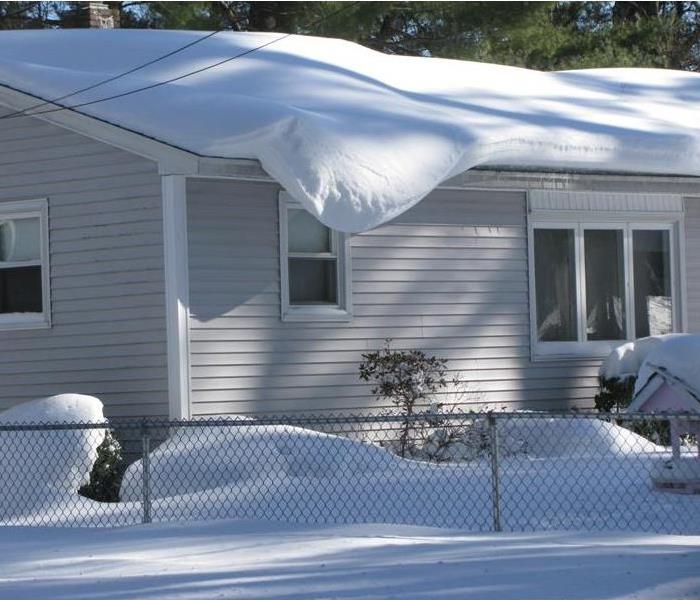Winter Snow Storm Preparation
11/16/2017 (Permalink)
A huge snow storm is coming. How do you prepare so that your home will suffer little or no damage? How do you keep your pipes from freezing? How do you know if your roof can support the weight of a few feet of snow? Will ice dams present a problem? What if you lose power? Don’t wait to discover the answers to these and other snow storm questions. Prepare before a snow storm or blizzard hits you. A major snow storm can dump snow so hard and fast that you suddenly find a giant blanket of white hanging over your house and you have to just hope the house survives intact.
Time And Safety
One great recommendation is to heed early weather warnings. Another is to be safe. If you have 48 hours to prepare you’re going to get a lot more done than if you wait until the snow starts falling. You may not realize how heavy snow can get. Snow is hard and heavy to shovel if it has a high water content. Don’t do anything that may risk your health or safety. Try to stay off ladders and the roof. Use a snow rake and stay safely on the ground to prevent winter storm damage cleanup.
Wet Snow Could Weigh 21 Pounds Per Foot
Fluffy, fresh snow can weigh as little as three pounds per square foot compared with 21 pounds for wet, heavy snow, according to FEMA. Ice weighs more: 57 pounds a square foot. Most roofs can support 20 pounds per square foot of snow, according to USA Today. And don’t forget about ice. An inch of ice equals about a foot of fresh snow, so 4 inches of ice on your roof could mean trouble. The steeper your roof, the less snow will accumulate. But if a portion of your home’s roof is flat, such as over a porch, take extra care to prevent snow and ice buildup there during a snow storm.
Don’t Let Water Pipes Freeze
To best protect your water pipes during and after a snow storm you need to think way ahead. If temperatures drop too low in your house during a power outage or your furnace malfunctions, your pipes can freeze and burst and cause extensive damage. So keep your house warm by using a generator or another alternative source of heat like a wood or coal stove. Seal your home’s doors and windows to hold in heat. Insulate any openings in your attic (vents, plumbing stacks, access doors, etc.). And wrap insulation around your pipes.
Prevent Ice Dams
Ice buildups at the roof edge or around drains keep melting snow from draining properly. This backs up, or dams, water into walls, ceilings, and insulation. Inspect your roof's drainage, keep gutters and downspouts clean, and trim trees to keep leaves to a minimum. Add insulation above the ceiling and increase roof ventilation to make the roof area warmer and prevent ice buildup. You can even install self-regulating heat cables on gutters, downspouts, and roof drains.
Use Caution With Alternative Heat Sources
Space heaters -- including electric, gas, pellet, and wood stoves -- can be great alternatives to constantly running the furnace and heating the entire house. The nonelectric heaters can also be helpful if the power goes out -- taking the heat with it -- during a snow storm, blizzard, or other harsh winter weather. But take care when installing or placing heaters. Make sure they meet safety standards and codes. Know how to use and maintain them. Otherwise, you risk a fire.
$893 Million In Property Damage
According to recent estimates from the National Fire Protection Association, home fires involving heating equipment caused $893 million in direct property damage and 400 civilian deaths in 2011. Often, these fires are caused by equipment that wasn't kept clean or was placed too close to something that could ignite. The association offers these heater safety tips.
• Keep flammable items, such as paper or bedding, at least 3 feet away from the heater.
• Buy a heating unit approved by a recognized testing lab (such as Underwriters Laboratories).
• Install the equipment according to local codes and manufacturer's recommendations.
• Use a licensed contractor.
• Make sure the heater vents to the outside so carbon monoxide won't build up indoors.
• Keep the vent clean and unclogged.
• Install carbon monoxide detectors.
• Have a qualified professional inspect and clean your heater annually -- before winter snow storms or blizzards hit.
Disaster Preparation Information
Every month on the SERVPRO of Manchester/Mansfield blog we publish educational articles on how to prevent natural disasters and deal with them quickly and effectively should they occur.
Here For You
The team at SERVPRO of Manchester/Mansfield has specialized training and experience in water damage restoration services, fire damage restoration services, mold remediation, commercial services, and natural disaster cleanup. Call SERVPRO of Manchester/Mansfield (860-649-0836) anytime, 24/7.
SERVPRO of Manchester/Mansfield
IICRC Certified
Ralph DiCristofaro
40 N. Main Street
Manchester, CT 06042
Call: 860.649.0836
Fax: 860.216.2762
24 hour emergency service






 24/7 Emergency Service
24/7 Emergency Service